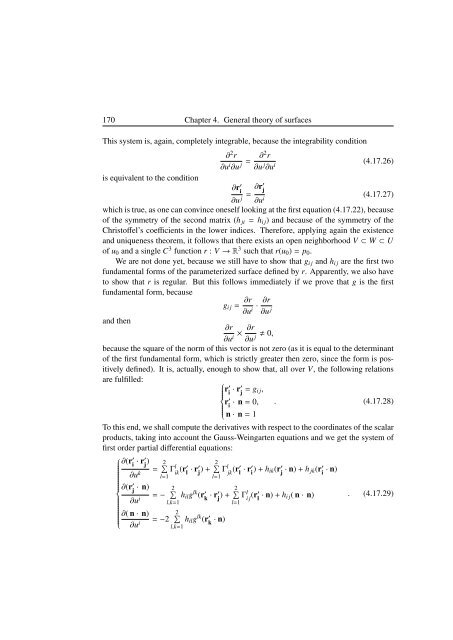Blaga P. Lectures on the differential geometry of - tiera.ru
Blaga P. Lectures on the differential geometry of - tiera.ru
Blaga P. Lectures on the differential geometry of - tiera.ru
Create successful ePaper yourself
Turn your PDF publications into a flip-book with our unique Google optimized e-Paper software.
170 Chapter 4. General <strong>the</strong>ory <strong>of</strong> surfaces<br />
This system is, again, completely integrable, because <strong>the</strong> integrability c<strong>on</strong>diti<strong>on</strong><br />
is equivalent to <strong>the</strong> c<strong>on</strong>diti<strong>on</strong><br />
∂2r ∂ui∂u j = ∂2r ∂u j∂ui ∂r ′ i<br />
(4.17.26)<br />
∂u j = ∂r′ j<br />
∂ui (4.17.27)<br />
which is t<strong>ru</strong>e, as <strong>on</strong>e can c<strong>on</strong>vince <strong>on</strong>eself looking at <strong>the</strong> first equati<strong>on</strong> (4.17.22), because<br />
<strong>of</strong> <strong>the</strong> symmetry <strong>of</strong> <strong>the</strong> sec<strong>on</strong>d matrix (h ji = hi j) and because <strong>of</strong> <strong>the</strong> symmetry <strong>of</strong> <strong>the</strong><br />
Christ<strong>of</strong>fel’s coefficients in <strong>the</strong> lower indices. Therefore, applying again <strong>the</strong> existence<br />
and uniqueness <strong>the</strong>orem, it follows that <strong>the</strong>re exists an open neighborhood V ⊂ W ⊂ U<br />
<strong>of</strong> u0 and a single C3 functi<strong>on</strong> r : V → R3 such that r(u0) = p0.<br />
We are not d<strong>on</strong>e yet, because we still have to show that gi j and hi j are <strong>the</strong> first two<br />
fundamental forms <strong>of</strong> <strong>the</strong> parameterized surface defined by r. Apparently, we also have<br />
to show that r is regular. But this follows immediately if we prove that g is <strong>the</strong> first<br />
fundamental form, because<br />
gi j = ∂r ∂r<br />
·<br />
∂ui ∂u j<br />
and <strong>the</strong>n<br />
∂r ∂r<br />
× � 0,<br />
∂ui ∂u j<br />
because <strong>the</strong> square <strong>of</strong> <strong>the</strong> norm <strong>of</strong> this vector is not zero (as it is equal to <strong>the</strong> determinant<br />
<strong>of</strong> <strong>the</strong> first fundamental form, which is strictly greater <strong>the</strong>n zero, since <strong>the</strong> form is positively<br />
defined). It is, actually, enough to show that, all over V, <strong>the</strong> following relati<strong>on</strong>s<br />
are fulfilled: ⎧⎪⎨⎪⎩<br />
r ′ i · r′ j = gi j,<br />
r ′ i · n = 0, . (4.17.28)<br />
n · n = 1<br />
To this end, we shall compute <strong>the</strong> derivatives with respect to <strong>the</strong> coordinates <strong>of</strong> <strong>the</strong> scalar<br />
products, taking into account <strong>the</strong> Gauss-Weingarten equati<strong>on</strong>s and we get <strong>the</strong> system <strong>of</strong><br />
first order partial <strong>differential</strong> equati<strong>on</strong>s:<br />
⎧<br />
∂(r ′ i · r′ j )<br />
⎪⎨<br />
⎪⎩<br />
∂u k<br />
∂(r ′ j<br />
∂ui = 2�<br />
Γ<br />
l=1<br />
l ik (r′ l · r′ 2�<br />
j ) + Γ<br />
l=1<br />
l jk (r′ l · r′ i ) + hik(r ′ j · n) + h jk(r ′ i · n)<br />
· n)<br />
= − 2�<br />
∂( n · n)<br />
∂u i<br />
l,k=1<br />
= −2 2�<br />
hilglk (r ′ k · r′ 2�<br />
j ) + Γ<br />
l=1<br />
l i j (r′ l · n) + hi j( n · n)<br />
hilg<br />
l,k=1<br />
lk (r ′ k<br />
· n)<br />
. (4.17.29)












